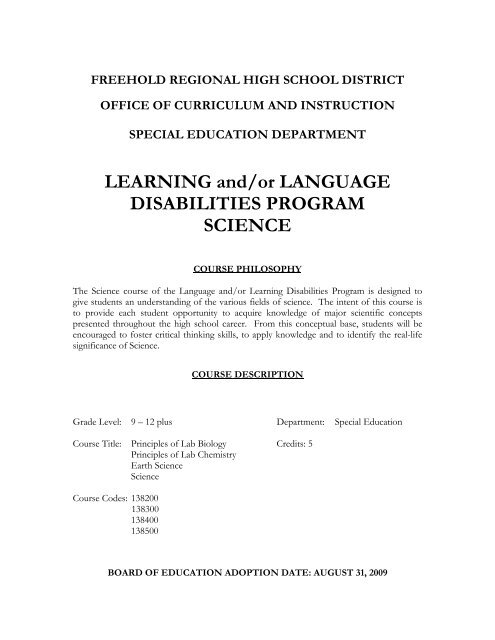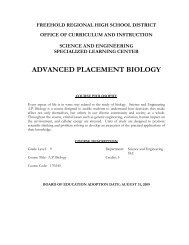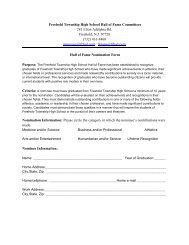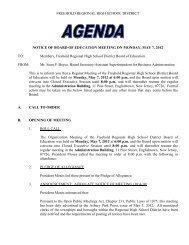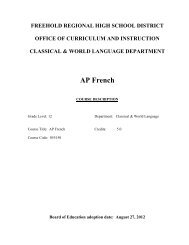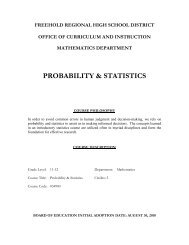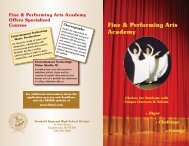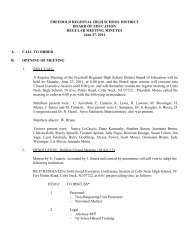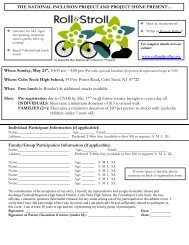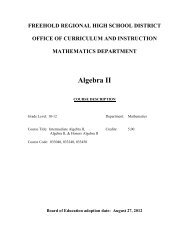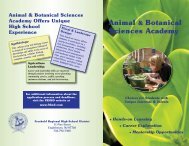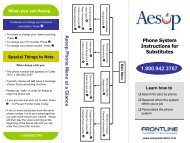LLD Science - Freehold Regional High School District
LLD Science - Freehold Regional High School District
LLD Science - Freehold Regional High School District
You also want an ePaper? Increase the reach of your titles
YUMPU automatically turns print PDFs into web optimized ePapers that Google loves.
FREEHOLD REGIONAL HIGH SCHOOL DISTRICTBoard of EducationMr. Ronald G. Lawson, PresidentMr. Christopher Placitella, Vice PresidentMr. William BrunoMr. Tom CaiazzaMrs. Elizabeth CanarioMr. Barry HochbergMrs. Kathie LavinMr. Heshy MosesMrs. Jennifer SuteraMr. James Wasser, SuperintendentMs. Donna M. Evangelista, Assistant Superintendent for Curriculum and InstructionCurriculum Writing CommitteeMs. Kristen MillerSupervisorsMs. Micki CrisafulliMs. Stephanie KayafasDr. Lenore KopelovichMs. Carollee MoorefieldMs. Debbie Perez-GilesMs. Nan Sullivan2
Course PhilosophyThe <strong>Science</strong> course of the Language and/or Learning Disabilities Program is designed to give students anunderstanding of the various fields of science. The intent of this course is to provide each student opportunity toacquire knowledge of major scientific concepts presented throughout the high school career. From this conceptualbase, students will be encouraged to foster critical thinking skills, to apply knowledge and to identify the real-lifesignificance of <strong>Science</strong>.Course DescriptionThe <strong>LLD</strong> <strong>Science</strong> course provides students opportunity to acquire knowledge and skills in a variety of sciencesoffered in the <strong>Freehold</strong> <strong>Regional</strong> <strong>High</strong> <strong>School</strong> <strong>District</strong>. Students will acquire knowledge in areas of science to include:Biology; Chemistry; Astronomy and Space <strong>Science</strong>; Earth <strong>Science</strong>; Environmental Studies and Physics. Thecurriculum is constructed to address and reinforce the New Jersey Core Content Workplace Readiness Skills as well asthe New Jersey Core Curriculum Content Standards for <strong>Science</strong>. The New Jersey Core Content Workplace ReadinessSkills are embedded within each unit of study. The New Jersey Core Curriculum Content <strong>Science</strong> Standards (5.1Scientific Processes, 5.2 <strong>Science</strong> and Society, 5.3 Mathematical Applications, 5.4 Nature and Process of Technology,5.5 Characteristics of Life, 5.6 Physical <strong>Science</strong>-Chemistry, 5.7 Physical <strong>Science</strong>-Physics, 5.8 Earth <strong>Science</strong>, 5.9Astronomy & Space <strong>Science</strong>, and 5.10 Environmental Studies) are the foundation for this curriculum.Interdisciplinary learning in reading, writing and computation will be integrated while providing for the differentiatedlearning styles of students.The units and topics covered in the Language and/or Learning Disabilities Program curriculum are as follows:• Scientific Inquiry, Safety, Mathematical Applications, <strong>Science</strong> and Technology• Biology: Matter, Energy, and Living Systems• Biology: Characteristics of Life• Chemistry: The Atom• Physics• Earth <strong>Science</strong>• Astronomy and Space• Biology: Environmental Studies3
<strong>Freehold</strong> <strong>Regional</strong> <strong>High</strong> <strong>School</strong> <strong>District</strong>Curriculum Map<strong>Science</strong> <strong>LLD</strong>RelevantStandards15.1A1, B1-2,C1EnduringUnderstandingsThe scientific methodprovides steps to answerquestions and solveproblems Safetyprocedures are in placefor the study of science.5.2B 1 People the world over andfrom throughout history,have contributed to thecontinual advancement ofscience and technology.5.3B15.3D1Mathematical applicationssuch as graphs andmeasurement are used astools in science.5.4A1 <strong>Science</strong> and technologyare mutually supportive indriving innovations inboth areas.5.5A1-4The natural world isdefined by organisms andlife processes whichconform to principlesregarding matter andenergy. Knowledge of theseprinciples can contribute toquality of life.Essential QuestionsHow do you solve problems in your daily life?What can experiments tell us?Why is an awareness of safety important?Who were some of the significant contributing scientists and what weretheir contributions to, e.g., laws of motion, Cell Theory etc.?Why do we use measurements in science?How are graphs used in science?How do science and technology work together?What are the characteristics of living things?Where do living things obtain energy?What is the structure and function of a cell?What are the major systems of the body?What is the Theory of Evolution?Diagnostic(before)Pre testsOral DiscussionPicturemanipulationDiagnosticTesting-assessprior knowledgeAssessmentsFormative(during)WrittenassignmentsBrief quizzeswrittenor oral tocheckunderstandingSafety ContractTeacherquestioningSummative(after)Unit tests oral,written.ProjectScoring rubricHow are living things classified?Why do you look similar to your parents?What is DNA?4
RelevantStandards15.5B1-25.5C1EnduringUnderstandingsLiving organisms may bedefined by similarcharacteristics that arepassed from one generationto the next. Theories existthat indicate thatcharacteristics of organismswithin a species may havechanged over time.Essential QuestionsWhat characteristics do all living organisms share?What is the Cell Theory?What are the structure and function of the cell membrane and organelles?How are macromolecules essential to everyday living?How and why do you sort things every day?What do the words evolution and extinct mean to you?Diagnostic(before)AssessmentsFormative(during)Summative(after)Why do you look like your parents?5.6A1-2, 5.6A55.6B15.7A2-35.7B1-2Matter is composed ofatoms. There exist threestates of matter. ThePeriodic Table ofElements contains everyknown element classifiedby the number of protonsin each atom.There exists arelationship betweenforce and motion.Various forms ofenergy exist, movethrough materials, andtransform from oneform to another.What is a gene?What is an atom?What are the three states of matter?What is the Periodic Table used for?What is a chemical reaction?Who is Dimitri Mendeleev?How is an object’s motion as well as its change in motion described?What happens when an object exerts force on another object?What are the effects of gravity?How is energy transferred?Why is energy constant in a closed system?5.8A15.8B15.8C1The Earth is a planetcomposed of interrelatedsystems which are everchanging and thereforecontribute to the dynamicnature of the planet. Somenaturally occurring systemsmay be modified by humanactivity.Who is Sir Isaac Newton?What are the components of the Earth?How do weather and climate affect the Earth?How has the Earth changed through history?5
RelevantStandards15.9A15.9B15.9D1EnduringUnderstandingsThe universe is composedof galaxies, each of which iscomposed of solar systemshaving the same elementsand governed by the samelaws. The planets and theirmoons move in predictablepatterns. The sun is a star.5.10A1 Some naturally occurringsystems may be modified byhuman activity.Essential QuestionsWhich patterns occur as a result of interaction between the Sun, Earthand Earth’s moon?How are the planets of our solar system alike/different?What are the elements necessary for sustaining life in Earth?What characteristics does our sun share with other stars?Is there an order to the universe?How would you describe the climate in which you live?How is our climate changing?Diagnostic(before)AssessmentsFormative(during)Summative(after)What does the ozone layer do for us?How is the ozone changing?What is erosion and deposition?What are some naturally occurring examples and some mane madeexample of erosion?5.10B1 Human activity maypositively or negativelyimpact the environment.Can you name some endangered species?How is human activity affecting the climate positively and negatively?How is human activity affecting the ozone positively and negatively?How is human activity affecting erosion positively and negatively?How is human activity affecting endangered species positively andnegatively?OralDiscussionDo NowVideo clipsDiagnosticTesting- forpriorknowledgeWrittenAssignmentsOnline ResearchDaily Quizzeswrittenor oralProjectsUnit tests-oral orwritten6
<strong>Freehold</strong> <strong>Regional</strong> <strong>High</strong> <strong>School</strong> <strong>District</strong>Course Proficiencies and Pacing<strong>Science</strong> <strong>LLD</strong>Unit Title Unit Understandings and Goals RecommendedDurationUnit #1: Scientific Inquiry,Safety, MathematicalApplications, <strong>Science</strong>and TechnologyUnit #2: Biology:Characteristics of LifeCommon scientific processes are employed by scientists to investigate the world around us, to depictscientific findings and to develop and share theory.1. The students will recognize processes that scientists employ and how they may pertain todaily life.The natural world is defined by the variety of organisms that have changed over time and aregrouped in a taxonomy based upon similar traits passed from one generation to the next.6 weeks6 weeksUnit #3: Chemistry: The AtomUnit #4: PhysicsUnit #5: Earth <strong>Science</strong>Unit #6: Astronomy and SpaceUnit #7: Environmental Studies1. The students will gain an understanding of diversity, biological evolution, heredity and therelationships among matter, energy and living systems.Matter is composed of atoms. The Periodic Table of Elements organizes elements to reflect theirproperties.1. The students will understand the significance of the structure of matter.Natural laws apply to the concepts of motion, force and energy transfer.1. The student will gain understanding that there exists a defined relationship among, energy,Force and motion.The Earth is ever-changing and is composed of interconnected systems. Some naturally occurringsystems that may be modified by human activity.1. The Earth is dynamic in nature due to the interrelationships of natural systems and humanactivity affecting the state of the geosphere, atmosphere and hydrosphere.Our solar system is part of the Milky Way Galaxy, one of many in the universe.1. The students will recognize the vast composition of the universe and will describe the patterns ofmovement among plants, suns, and moons.Human activities impact the cycling of matter and the flow of energy through ecosystems.1. The students will demonstrate knowledge of the effects humans have on the environmentand will discover ways in which they may contribute positively to environmental concerns.4 weeks4 weeks5 weeks4 weeks5 weeks7
<strong>Freehold</strong> <strong>Regional</strong> <strong>High</strong> <strong>School</strong> <strong>District</strong><strong>LLD</strong> <strong>Science</strong>Unit #1: Scientific Method and MeasurementsEnduring Understanding: Common scientific processes are employed by scientists to investigate the world around us, to depict scientific findings and todevelop and share theory.Essential Questions: How do you solve problems in your daily life?Why is an awareness of safety important?How are graphs used in science?What can experiments tell us?Why do we use measurements in science?How do science and technology work together?Unit Goal: The students will recognize processes that scientists employ and how they may pertain to daily life.Duration of Unit: 6 weeksNJCCCS: 5.1A1, B1-2, C1, 5.3B1, 5.3D1, 5.4A1Guiding / Topical QuestionsWhat are the safety rules that must befollowed when conducting experiments?How can you solve a problem or answera question using the Scientific Method?Content, Themes, Concepts, and SkillsUnderstand and apply information, skills, andprocedures developed from the district safetyprogram as it directly relates to the study ofscience.Review steps to the scientific method and besure to include: observation, hypothesis,prediction, and control vs. experimental group,and independent vs. dependent variable.InstructionalResources andMaterials<strong>District</strong> safety rulesWorksheetsSolve a problemusing the ScientificMethod withstudents.WorksheetsTeaching StrategiesRead aloud the district-wide safety rules.Show lab safety equipment in theclassroom: fire extinguisher, fume hood,safety shower, eyewash, and fire blanketand demonstrate how to use them.Provide the students with illustrationsof safety procedure not being followed.Students then circle and verbally explainwhat is wrong and what would be thecorrect procedure.Role-play the safety procedurescorrectly.Group Activity: Organize students ingroups to solve a problem using thescientific method.Students manipulate steps into thecorrect orderAssessmentStrategiesProvide a lab that willdemonstrate the use ofappropriate equipment,techniques, and safety.Observe studentsduring the actual laband review theirprocedures in regardsto techniques andsafety.Students must sign andhave parental signatureof the safety contract.Students must pass asafety quiz.Students present thegroup activity and havediscussion.Verbal Quiz onScientific Method.8
Guiding / Topical QuestionsHow is data generated, displayed, andanalyzed?Content, Themes, Concepts, and SkillsDiscuss procedures for making line, pie, and bargraphs.InstructionalResources andMaterialsDemonstrate how tocreate a line, pie, andbar graphs by givingsample data.Worksheets withexamplesTeaching StrategiesRead and interpret given graphscontaining data to which students mayrelate.Give students a topic and survey theclass to obtain data and have themdevelop a graph.AssessmentStrategiesCollect and gradegraphs.Quiz on graphing.What are the base units ofmeasurements in the SI System?How do we use technology in science?Define length, weight, volume and temperature.Discuss the equipment used to measure length,weight, volume, and temperature.Discuss the base units for length, weight,volume, and temperature.Identify instruments of technology used inscience including microscopes, computers,balances, etc.Identify scientific discoveries made possiblethrough the invention of technology as well asthe evolution of technology through theadvancement o science.Demonstrateequipment that wouldbe used to measurelength, weight,volume andtemperature.Frayer models forimportant vocabularyGive students variousobjects to measurelength,, weight,volume, andtemperature.WorksheetsModeling of differentinstrumentsMicroscopeProvide graphing exercise with givendata.Complete worksheet, board work, orgraphic organizer on measurement, baseunit, and equipment.Give worksheet with practice problems,allow to students to identify theinformation.Students identify items in the homemeasured in metrics or used in metricquantitiesPaper Measurement LabStudents identify names and uses ofdifferent instruments of technologyAllow students to use as many types oftechnology as possibleDiscuss microscope and MRI machineas tools to advance science and viceversa.Written and oralresponses to academicprompts.Lab ReportQuiz on MeasurementQuiz on technologyinstrumentidentificationUnit TestSuggestions on how to differentiate in this unit:• Give copies of notes to students instead of having them read them.• Tape an oral version of the notes for those that cannot read.• Complete the lab as a class activity instead of individual groups.• Use pictures as notes instead of written words• Suggested demonstration: ice water balloon activity• Suggested website: Scientific Method Worksheets: http://www.biologycorner.com/worksheets.php9
<strong>Freehold</strong> <strong>Regional</strong> <strong>High</strong> <strong>School</strong> <strong>District</strong><strong>LLD</strong> <strong>Science</strong>Unit #2 Biology: Characteristics of LifeEnduring Understanding: The natural world is defined by the variety of organisms that have changed over time and are grouped in a taxonomy based uponsimilar traits passed from one generation to the nextEssential Questions: What are the characteristics of living things?Where do living things obtain energy?What is the structure and function of a cell?What are the major systems of the body?What is the Theory of Evolution?How are living things classified?Why do you look similar to your parents?What is DNA?Unit Goal: The students will gain an understanding of diversity, biological evolution, heredity and the relationships among matter, energy and living systems.Duration of Unit: 6 weeksNJCCCS: 5.2B1, 5.5A1-4, 5.5B1-2, 5.5C1Guiding / TopicalQuestionsWhat is the difference betweenliving and non-living things?Content, Themes, Concepts, andSkillsDiscriminate between living and non-livingthings using criteria.InstructionalResources andMaterialsCurrent textbook andresource bindersTeaching StrategiesClass discussion. Students work in pairs, createtwo lists containing living and non-living things.List the characteristics of the living organisms.AssessmentStrategiesWritten or OralAssignmentWhat are the characteristics of aliving thing?Criteria used to determine whether or notan object is livingPicturesGraphic organizersList the characteristics of living things.Given characteristics, students identify objects asliving or non-living.Students work in pairs use checklist ofcharacteristics to determine if an object is livingor non-living.Class participationProject assessmentCooperativelearning experienceStudents make collage of pictures of living things.What is Cell Theory? Ideas that constitute Cell Theory. Internet resources. List components of cell theory. Use video clips toillustrate.What is the structure and Basic parts of a cell and their functions. Activitiesfunction of cell parts?Difference/similarities between plant andanimal cells.ModelsIllustrationsInternet displaysStudents make an edible cell. Use jello-likesubstance as cytoplasm. Insert objects torepresent cell parts.Students color illustrations of plant and animalcell parts using same colors for similar parts andsingle colors for parts that are found in one celltype only.Class discussionProjectClass workStudents create a poster labeling plant and animal10
Guiding / TopicalQuestionsContent, Themes, Concepts, andSkillsInstructionalResources andMaterialscell parts.Teaching StrategiesAssessmentStrategiesHow do cells and multicellularorganisms obtain energy?Living things produce and expend energy.Purpose and relationship between cellularrespiration and photosynthesis.Organisms, energy and the food chainInternet displays andinteractive activitiesIllustrationsDiagramGraphic OrganizerRole playExplain that one characteristic of living things isthe need for and expenditure of energy.Inform students that energy begins at the cellularlevel.Explain that animal and plant cells both requirefood for energy.Allow students to role-play as a plant and ananimal in terms of obtaining food for energy.Class discussion andparticipationMultimediapresentationsRole playDiagramShow illustration of the cycle of photosynthesisand cellular respiration. Students color in parts asteacher provides explanation.Show and design food web and chain.Students observe the food chain by setting up anaquarium or terrarium using various organisms.Role play an organism in the food chain. Becomemore energized at each level as organisms areconsumed.What are the basic functions ofthe major systems of the humanbody?Hierarchy of cells, tissues, organs, andorgan systemsInterrelationships among major organsystems.Some diseases lead to organ system failureGraphic organizersActivitiesIllustrationsManipulativesAudio and visual aidsManipulativesUse student every day experiences to explainvarious components, e.g.,ask students the meaning off “cardio” as it relatesto their Physical Education class. Explain therelationship to the cardio-vascular (heart-lungs)system of the body. Ask what happens to foodafter students eat lunch. Tie in digestive system.Relate to transfer of energy.Use pictures and video clips to illustrate eachsystem. Discuss interrelationships in terms ofenergy.Class discussionand participationMultimediapresentationsProjectsRubricsCooperativelearning experiencesInternet displays andinteractive activitiesStudents create poster of one organ system. Classdiscussion regarding interrelationships amongsystems.Discuss diseases that may lead to system failure.11
Guiding / TopicalQuestionsHow are all living things recordedand organized?Content, Themes, Concepts, andSkillsSystem for the classification of living thingsInstructionalResources andMaterialsCurrent textbooks andresource bindersStudent worksheetsDemonstrationsGraphic OrganizersTeaching StrategiesDescribe characteristics of various types oforganisms within a single species. Ex. Dogs.Classify according to similar traits.Class discussionGive students various items to classify using theirown method. Determine criteria that they usedvia suggestion and discussion.AssessmentStrategiesWritten or OralAssignmentsProject assessmentsClass participationClassification QuizPlay match game. Match pictures to correctkingdomUtilize flashcards to divide animals into kingdomsReport on a specific kingdomWhat is heredity?Define heredity and the role DNA plays ininheritance of traitsGenes determine individualtraits/characteristics.Traits are passed from one generation toanother.Each organism is the result of inheritanceof parental genes. Dominant traits areexpressed over recessive.Use a Punnett square to determine chanceof genetic outcomes.Internet resourcesCurrent textbooks andresource bindersStudent worksheetsDemonstrate PunnettsquareInternetVideo clipsMake a collage of living things belonging to aparticular kingdom.Define traits. Demonstrate of certain hereditarytraits such i.e. rolling the tongueExplain use of letters to symbolize traits. Matchgame.Construct a model of the DNA moleculeLook at pictures of family members to observefamily traits Divide paper in half have student listtheir traits and traits of family memberUse coins to depict traits. Ex. Heads blue eyes,tails brown. Students flip coins to determineinherited traits and draw them on an outline of anapplicable organism (human, animal etc.) todetermine outcome.Written or OralassignmentsProject assessmentObservations ofcontinued workRecognize the contribution of GregorMendel to inheritance.Collect data regarding traits from classmatescolor hair, color eyes etc. Use information tomake a bar graph.Family tree projectDicuss life and contributions of Gregor Mendel.Show illustrations.12
Guiding / TopicalQuestionsContent, Themes, Concepts, andSkillsInstructionalResources andMaterialsTeaching StrategiesAssessmentStrategiesComplete a Punnett square.What is evolution?Theory of evolutionAdaptation and environmental factors mayaffect natural selection.Individuals vary within a species. Some aremore likely to survive to reproduce.History of evolutionary theory (CharlesDarwin etc.)Current textbooksEvolution PowerPointVideo clipsInternetDiscuss why animals like the dinosaurs and woolymammoth no longer exist.Make a gene data sheet. Students will observemembers of their family. Note variations in traits.Students complete a project that demonstrates ananimal may have changed over generations. i.e.monkey, horseProject assessmentWritten or oralassignmentsDiscussionparticipationUnit TestSuggestions on how to differentiate in this unit:• For nonverbal students, use pointing motions to discuss the topics covered• For family tree project use verbal skills if students completing the project is not possible or use pictures instead of words• Give students classification areas and then have them cut and paste objects into the boxes instead of having them create the areasSuggested websites: Lesson plans, worksheets etc.: http://classroom.jc-schools.net/sci-units/matter.htm; Pictures of states of matter:http://www.grc.nasa.gov/WWW/K-12/airplane/Images/state.gif13
<strong>Freehold</strong> <strong>Regional</strong> <strong>High</strong> <strong>School</strong> <strong>District</strong><strong>LLD</strong> <strong>Science</strong>Unit #3 Chemistry: The AtomEnduring Understanding: Matter is composed of atoms. The Periodic Table of Elements organizes elements to reflect their properties.Essential Questions: What is an atom?What are the three states of matter?What is the Periodic Table used for?What is a chemical reaction?Who is Dimitri Mendeleev?Unit Goal: The students will understand the significance of the structure of matter.Duration of Unit: 4 weeksNJCCCS: 5.2B1, 5.6A1-2, 5.6A5, 5.6B1InstructionalGuiding / Topical Questions Content, Themes, Concepts, and Skills Resources and Teaching StrategiesWhat is the difference between a solid,liquid and a gas?Identify the properties of a solid, a liquid and agas.MaterialsPicturesModelsAsk students if they used blocks to buildsomething, beads to make jewelry etc.?Label pictures and objects in theclassroom as a solid. Liquid or gasAssessmentStrategiesClass participationCollage projectMake collage of picturesLabel water, an ice cube and steam (mayuse pictures) as a solid, liquid or gasWhat is an atom?History of Atomic TheoryDiscuss atoms as the building block for matter.Structure of the atom - subatomic particlesModel of an atomCurrent TextbooksPowerPointpresentationdemonstrating howthe parts of an atomfit together.Students draw and label the atom as itexists nowDiscussion of why atoms are importantWeb quest on an important scientist toatomic theoryProject AssessmentWritten and oralassignmentsParts of an Atom Quiz14
Guiding / Topical QuestionsWhat is a chemical reaction?Content, Themes, Concepts, and SkillsSome chemical substances may react with eachother resulting in change.InstructionalResources andMaterialsMetal containing rust.<strong>District</strong> approvedchemicalsTeaching StrategiesShow examples. Name chemicalsinvolved. Describe resulting change.Ex: Oxygen and Iron yield rustInvite chemistry teacher to demonstratedistrict approved chemical reactions inthe science lab to students.AssessmentStrategiesClass participation anddiscussion.What is the periodic table?Parts of the periodic table i.e. groups andperiodsParts of each element block i.e. atomic number,atomic mass, chemical symbol, chemical nameHistory of the Periodic TableClassification of elements into metals,nonmetals, metalloidsImportance of element’s placement on periodictablePeriodic TrendsRecognize contribution of Dimitri Mendeleevregarding the Periodic table.Periodic TablereprintsPeriodic TablePowerPointpresentationCurrent TextbooksPeriodic TrendsPowerPointColor Periodic Table to demonstrate thedifferent areas of classification i.e. blue=metalsLabel one block of periodic tableActivity where students figure out asmuch as possible using only the PeriodicTable i.e. Helium has 2 protons, 2electrons or Potassium shares some ofthe same characteristics as SodiumUtilize Periodic Table that containspictures of elements as well as chemicalsymbol. Bring in samples of someelements to show students (ex. copper.)Place on Periodic Table.Text and pictures of Dimitri Mendeleevand his accomplishments.Project assessmentWritten and oralassignmentsPeriodic Table QuizUnit TestSuggestions on how to differentiate in this unit:• For nonverbal students have them point to where a label should go instead of writing the labels• Give students a word bank to use when labeling• Helpful websites: Periodic Table- classified by state: http://www.gtcocalcomp.com/erc/interwritebackgrounds/periodic_table_complete.jpg; Blank Periodic Table:http://www.sciencegeek.net/tables/CA_CST.pdf; Interactive periodic table: www.webelements.com15
<strong>Freehold</strong> <strong>Regional</strong> <strong>High</strong> <strong>School</strong> <strong>District</strong><strong>LLD</strong> <strong>Science</strong>Unit #4 PhysicsEnduring Understanding: Natural laws apply to the concepts of motion, force and energy transfer.Essential Questions: How is an object’s motion as well as its change in motion described?What happens when an object exerts force on another object?What are the effects of gravity?How is energy transferred?Why is energy constant in a closed system?Who is Sir Isaac Newton?Unit Goal: The student will gain understanding that there exists a defined relationship among, energy, force and motion.Duration of Unit: 4 weeksNJCCCS: 5.2B1, 5.7A 2-3, 5.7B1-2InstructionalGuiding / Topical Questions Content, Themes, Concepts, and Skills Resources and Teaching StrategiesWhat is the relationship betweenmotion and force?Determine if an object is moving.Recognize contribution of Sir Isaac Newtonregarding the laws of motion.Determine forces that cause movement and cancause objects to stay together.Explain that when one object exerts force onanother, force is also applied to the first object.Recognize gravity as a force of attractionbetween masses.Explain that heat, electricity, sound and light areforms of energy.Explain that energy can be transformed fromone form to another.MaterialsPicturesNotes withillustrationsActivitiesRole-playPower pointpresentationsManipulativesInternet displays andinteractive activitiesAudio and visual aidsStudents to remain still, thendemonstrate movement using the body(waving, walking, jumping.)Demonstrate movement of objects.Show video clip of an outdoor andindoor scene. Students identify what ismoving.Students push against an objectincrementally using their hands until theobject moves to demonstrate that forceis applied not only to the object, butalso to the hand.Think ,Pair, Share to discuss picturecontentClass activity on different types offorcesShow the three lawso f motion inaction using video clipsFrayer models of acceleration, gravity,and forceAssessmentStrategies<strong>Science</strong> JournalTest and quizzesCooperative andindependent learningexperiencesClass work andhomeworkClass discussion andparticipationMultimediapresentationsProjectsSelf assessmentPortfolio assessmentRubrics16
Guiding / Topical QuestionsContent, Themes, Concepts, and SkillsInstructionalResources andMaterialsTeaching StrategiesVideo clips of history of Sir IsaacNewton and his accomplishmentsAssessmentStrategiesWhat is energy?Define energyForms of energy including kinetic, potential,mechanical, electrical, light, heat, etc.Current textbook andworksheetsPowerPointpresentation onenergy and its manyformsInternetEnergy Video clipsFrayer model of energyDemonstrations of forms of energy i.e.light bulb = electrical + light + heatenergyActivity to find as many energy forms aspossible in schoolRoller coaster activity demonstratingkinetic, potential, and mechanical energyWritten and oralassignmentsProject assessmentParticipation indemonstrationsEnergy QuizUnit TestSuggestions on how to differentiate in this unit:• Create pictorial descriptions of 3 laws instead of auditory notes.• Instead of using frayer models, have students look at pictures that define terms.• Useful Websites: Mini-labs on Newton: http://teachers.net/lessons/posts/661.html;Newton’s Laws of Motion Activities:http://www.lth3.k12.il.us/tworivers/Pet%20Projects/Pam%20Winterroth/pam%20winterroth%27s%20final%20project/Newton%27s%20laws%20of%20motion%20activities%20page.html17
<strong>Freehold</strong> <strong>Regional</strong> <strong>High</strong> <strong>School</strong> <strong>District</strong><strong>LLD</strong> <strong>Science</strong>Unit #5 Earth <strong>Science</strong>Enduring Understanding: The Earth is ever-changing and is composed of interconnected systems. Some naturally occurring systems that may be modifiedby human activityEssential Questions: What are the components of the Earth?How do weather and climate affect the Earth?How has the Earth changed through history?Unit Goal: The Earth is dynamic in nature due to the interrelationships of natural systems and human activity affecting the state of the geosphere, atmosphere andhydrosphereDuration of Unit: 5 weeksNJCCCS: 5.8A1, 5.8B1, 5.8C1, 5.10AGuiding /TopicalQuestionsWhat are the partsof the Earth?Content, Themes, Concepts, andSkillsParts of the Earth i.e. crust, mantle, outercore, inner coreParts of the Earth’s atmosphere i.e.troposphere, stratosphere, mesosphere,thermosphereInstructionalResources andMaterialsCurrent textbooks andworksheetsIllustrationsBlank diagramsInternetPowerPoint Presentationon the parts of Earthand the atmosphereTeaching StrategiesStudents label parts of the Earth on a blank diagramStudents label parts of the atmosphere on a blank diagramStudents list parts of the atmosphere with their altitude andtemperatures.AssessmentStrategiesProjectAssessmentOral and WrittenAssignmentsEarthComponent quizWhat are thegeosphere,hydrosphere,atmosphere andbiosphere?Describe elements of and discussrelationships among the geosphere,hydrosphere and atmosphere.Use the theory of plate tectonics toexplain relationships among mountains,mid-ocean ridges, earthquakes andvolcanoes.Current textbooks andworksheetsIllustrationsFrayer model forvocabulary termsWorld mapGroup students. Give each group pictures representing each system.Ask students to group them under the categories land, water and air.Provide a model of the Earth, one container each of water, soil, andan empty container labeled air. Point to portions of the model of theEarth that relate to contents of each container.Students discuss view out of classroom window to determine whichsystems are visible and which are not.<strong>Science</strong> journalof observationsProjectassessmentParticipation indiscussionsGlobePaper to represent platesStudents view video clips to identify relationships among systemsrepresented.Students are given a map of the earth and cards that represent eachsystem. Students place cards on portions of the map that representeach system.18
Guiding /TopicalQuestionsContent, Themes, Concepts, andSkillsInstructionalResources andMaterialsTeaching StrategiesAssessmentStrategiesMove plates made of paper over surface of globe to simulate tectonicmovement.What are the effectsof weather andclimate on Earth?Define climate and weatherDifferent types of climate around theworldChanges in climate over historyEffects of climate (long term) andweather (short term) on Earth.Describe the effects of human activity onclimate?PowerPoint presentationon the effects of climateand weather on Earth toinclude natural disastersCurrent textbooks andworksheetsWorld map showingvarious climates.Articles categorizing theeffects of human activityon climate.Internet resourcesPoint out relationships of shapes of coastlines of land masses onworld map that indicate that land masses may have been connectprior to shifting of plates.Students color map to demonstrate different types of climates in theworld.Discuss how people have adapted to climate change.Frayer model - climateStudents research changes in climate over history and possiblereasons for the changes.Students select one natural disaster and do research to find out moreabout the disaster. They can either write a report or create apresentation on the natural disaster.ProjectassessmentParticipation indiscussionsWeather andClimate Quiz(oral, written orillustrations)ProjectAssessmentOral and WrittenAssignmentsFrayer Model forvocabularySuggestions on how to differentiate in this unit:• Instead of writing labels have students use Velcro to attach labels in the correct places.• If students can’t color the map have them label or use Velcro.• Instead of writing research, have them orally discuss, or type.• Useful Websites: Layers of Earth diagram: http://www.deafhoosiers.com/sci/soarhigh/lithosphere/earthcut.jpg;Earth’s Atmospheric Layers: http://starryskies.com/solar_system/Earth/atmosphere.jpg;Blank World Map: http://homer.ugdsb.on.ca/jfr/jfr_geog/cgr/cgr_unit2/worldpoliticalmap2003.JPGUnit Test19
<strong>Freehold</strong> <strong>Regional</strong> <strong>High</strong> <strong>School</strong> <strong>District</strong><strong>LLD</strong> <strong>Science</strong>Unit #6 Astronomy and SpaceEnduring Understanding: Our solar system is part of the Milky Way Galaxy, one of many in the universe.Essential Questions: Which patterns occur as a result of interaction between the Sun, Earth and Earth’s moon?How are the planets of our solar system alike/different?What are the elements necessary for sustaining life in Earth?What characteristics does our sun share with other stars?Is there an order to the universe?Unit Goal: The students will recognize the vast composition of the universe and will describe the patterns of movement among plants, suns, and moons.Duration of Unit: 4 weeksNJCCCS: 5.9A1, 5.9B1, 5.9D1Guiding /TopicalQuestionsWhat are thecycles of Earth,the moon, andthe Sun?Content, Themes, Concepts, and SkillsStructure of our solar system as one of many in the Milkyway Galaxy.Movement of planets and moonsConcept of time related to movement of the EarthThe sun as a star that may be at the center of a solarsystem around which planets revolve. The sun producesheat and light.InstructionalResources andMaterialsCurrent textbooksand worksheetsPowerPointpresentation onthe Lunar Cycleand the Earth’sCycleDiagramsTeaching StrategiesAsk students to describe what they see when looking at the skyduring the day and at night.Students create diagrams or models of our solar systemStudents role play movement in the solar systemStudents label moon phases on blank diagram including newmoon, waxing crescent, first quarter, waxing gibbous, fullmoon, waning crescent, last quarter, waning gibbousAssessmentStrategiesParticipation indiscussionProjectassessmentEarth CyclesquizThe Earth’s revolution around the sun- 365 days to getaround the sun, etc.ModelsStudents categorize how long it takes the Earth to go aroundthe sunThe earth’s rotation – 24 hoursThe Lunar Cycle- 8 phasesHow the Earth stays on its cycle around the sun. Revisitgravity from Isaac Newton’s perspectiveActivity that demonstrates how the Earth stays on its pathgoing around the sunDiscuss how the sun is necessary for life.What are thecomponents ofour universe?Define galaxy, universe, planet, solar system, starComponents of our universeCurrent textbooksand worksheetsFrayer models of galaxy, universe, planet, solar system and starStudents fill in diagram of the types of galaxies. Write aboutUniverse QuizProject20
Guiding /TopicalQuestionsContent, Themes, Concepts, and SkillsTypes of galaxiesComponents of the solar system that contains EarthTypes of StarsLife Cycle of a StarInstructionalResources andMaterialsDiagrams of typesof galaxiesSolar SystemdiagramLife Cycle of aStarDiagram of theuniversetheir favorite typeTeaching StrategiesStudents fill in Solar System diagramStudents fill in Life Cycle of a Star. Discuss what point our bigstar the sun is inAssessmentStrategiesassessmentParticipation inDiscussionWritten andOralassignmentsUniversePowerPointpresentation• Suggestions on how to differentiate in this unit:• If students can’t complete diagrams have them show demonstrate knowledge by pointing where the labels should go• They may do a presentation on their favorite type of galaxy instead of writing.• The Life Cycle of a Star can be acted out.• Useful websites: Lunar Cycle: http://www.nrc-cnrc.gc.ca/images/education/moon-cyc.gif; Life Cycle of a Star:http://www.seasky.org/cosmic/assets/images/starlife.jpg;Types of Galaxies: http://starchild.gsfc.nasa.gov/Images/StarChild/universe_level1/galaxies.gif21
<strong>Freehold</strong> <strong>Regional</strong> <strong>High</strong> <strong>School</strong> <strong>District</strong><strong>LLD</strong> <strong>Science</strong>Unit #7 Environmental StudiesEnduring Understanding: Human activities impact the cycling of matter and the flow of energy through ecosystems.Essential Questions: How would you describe the climate in which you live?How is our climate changing?What does the ozone layer do for us?How is the ozone changing?What is erosion and deposition?What are some naturally occurring examples and some mane made example of erosion?Can you name some endangered species?How is human activity affecting the climate positively and negatively?How is human activity affecting the ozone positively and negatively?How is human activity affecting erosion positively and negatively?How is human activity affecting endangered species positively and negatively?Unit Goal: The students will demonstrate knowledge of the human effect on the environment and will discover ways in which they may contribute positively toenvironmental concerns.Duration of Unit: 5 weeksNJCCCS: 5.10A1, 5.10B1Guiding / Topical QuestionsHow do humans effect the environmenttoday? Positively? Negatively?What might “the balance of nature”mean?Content, Themes, Concepts, and SkillsDiscriminate between climate and weather.Identify climates as hot or cold, rainy or dry,seasonal.Define the purpose of the ozone layer.Define erosion.Define endangered species.Define balance, nature, naturally occurring,man-made, climate, ozone, erosion, deposition,endangered, species, environment andpollution.InstructionalResources andMaterialsPictures of variousclimates, e.g., desertarctic, rain forest etc.Internet resourcesCurrent textbook andworksheetsInternet resourcesTeaching StrategiesStudents describe pictures of climates.Chose a climate to illustrate.Shoe illustrations of ozone layer, erodedbeaches and endangered speciesFrayer models of naturally occurring,man-made, climate, ozone, erosion,deposition, endangered, species,pollution and environment.AssessmentStrategiesIllustrationPicture identificationPicture identificationParticipationDistinguish naturally occurring process fromthose positively or negatively affected by humanactivity regarding climate change, ozoneproduction, erosion and deposition andthreatened and endangered species.Balance scaleVideo clips/picturesRole-playUse balance scale to illustrate how theaddition of pollutants may shift thebalance of nature.Discussion22
Guiding / Topical QuestionsHow can humans help to preventpollution?Content, Themes, Concepts, and SkillsVarious types and causes of pollutionEffects that students may have on theenvironmentTypes of receptacles are for certain types oftrash and recyclingDefine ecosystemEnvironmental pollution and the water CycleInstructionalResources andMaterialsInternet resourcesTrash receptaclesused in schoolDiagram of WaterCyclePowerPointPresentation onpollutionTeaching StrategiesUse internet resources to showexamples of polluted environments.Explain elements of the environment.Explain what environment might havebeen like prior to polluted state.Point out trash receptacles used inschool for recycling purposes.Brainstorm ways in which students mayhelp to protect the environment.Label water cycleAssessmentStrategiesParticipation in classdiscussion.Oral and writtenassignmentsUse the water cycle to explain thenegative affects that pollution may haveon the environment.Students select type of pollution andresearch and present on that topic andits effects. Students research ways ofminimizing environmental pollution.Suggestions on how to differentiate in this unit:• Students may make a diorama on the water cycle instead of writing the labels.• Students could go on a class trip to various places to learn about pollution.• Useful websites: Water cycle website: http://www.kidzone.ws/water/; Pollution Poster: http://www.pages.drexel.edu/~cy34/23


